Kids Wear Market Research, 2032
The global kids wear market was valued at $194.1 billion in 2022, and is projected to reach $286.9 billion by 2032, growing at a CAGR of 4.1% from 2023 to 2032.
Kids wear is also known as children's clothing. It includes a diverse range of garments, foot wear and accessories designed exclusively for children, from infants to teenagers. This category includes clothing tailored to the unique needs and sizes of children, such as infant wear for babies, playful and comfortable toddler clothing, school uniforms, stylish attire for teenagers, outerwear to shield them from the elements, sportswear for active pursuits, formal wear for special occasions, sleepwear for restful nights, and a variety of footwear and accessories. Kids wear is carefully designed to prioritize comfort, safety, and age-appropriate styles while often featuring colorful patterns, whimsical characters, and themes that resonate with children's interests. The sizing and fit take into account the rapid growth and evolving body proportions of children, ensuring that they can move, play, and express themselves comfortably.
MARKET DYNAMICS
Globally, the population's demographic makeup has a big impact on the kids' clothing market. The increase in demand for children's apparel is a result of rising birth rates and population expansion. Increased birth rates or increase in the number of children in the population have directly led to a rise in the demand for children's clothing. This has forced merchants and manufacturers to broaden their product offerings to meet the growing demand. The change in urbanization trend culture diversity and family size have opened up opportunities for specialized products and adaptations. Moreover, to meet the needs of the diverse consumers, manufacturers have followed strategic planning. Furthermore, the quantity and kind of clothing that parents buy for their children has also been influenced by lifestyle decisions. It includes delaying motherhood or having smaller families. In addition, shifts in the economy and society, such as the entry of women into the workforce, have affected family structures and consumer behavior. As both parents work, they do not have as much time for traditional clothes buying, which makes them prefer easy and online solutions. The market for children's clothing has grown due to the aforementioned considerations.
Moreover, the market for children's wear is significantly impacted by the changing fashion and style preferences of parents and other caregivers. Parents are frequently looking for apparel that fits in with the latest trends and expresses their own sense of style, which has increased the demand for kids' clothes. This is also due to changes in fashion trends, such as a desire for gender-neutral clothing or eco-friendly materials. Kids' fashion trends spread quickly owing to the influence of celebrities and the media, as well as the widespread use of social media. The demand for environment-friendly children's clothing is driven by a growing consciousness of sustainability.
However, price is a factor that parents and other caregivers frequently consider while buying children's clothing. Kids grow out of their clothes quickly, so affordable solutions are more enticing. Retailers struggle to find a way to keep their profit margins while yet providing customers with reasonably priced options. Moreover, particularly when it comes to apparel for infants and toddlers, companies' and retailers' pricing power is constrained by the market's sensitivity to price. Children have a wide range of clothing needs, from playwear to school uniforms and special events, which makes the problem of price sensitivity worse. Customers are being drawn away from traditional merchants by less expensive options like hand-me-downs and secondhand stores. Kids' wear companies and merchants frequently concentrate on supplying affordable lines, holding specials and promotions, and offering adaptable, long-lasting clothing options to maximize value for money, but still at some point the growth of the market is hampered by these constraints.
Fit and sizing concerns act as a major barrier in the kids' clothing market. Parents find it challenging to anticipate their children's ideal size owing to quick growth among kids. This frequently leads to exchanges and returns, which incurs additional expenses for retailers as well as customers. Since children outgrow clothes quickly, parents frequently struggle to guess the right size, necessitating returns and exchanges. The uneven sizing guidelines that are common in business between companies and even within the same brand make this problem much more difficult. The problem is made worse by the broad age span that children's clothing covers, from newborns to teenagers, since these developmental stages have quite different clothing needs and sizes.
A number of elements come together to create a compelling potential for the kids' clothing sector to include novel materials. These materials have many benefits as they include hypoallergenic and high-performance textiles as well as eco-friendly and sustainable fabrics. They offer parents tremendous value by not only meeting the growing need for eco-friendly clothing options but also by offering long-lasting, premium solutions that resist deterioration. Innovative material adoption can help brands project an eco-friendly image, stand out in a crowded market, and draw in customers looking for cutting-edge, inclusive, and safe children's apparel. Moreover, this is a chance for brands to accomplish sustainability targets while appealing to a discerning and knowledgeable client base, as customers become more aware of the advantages of novel materials.
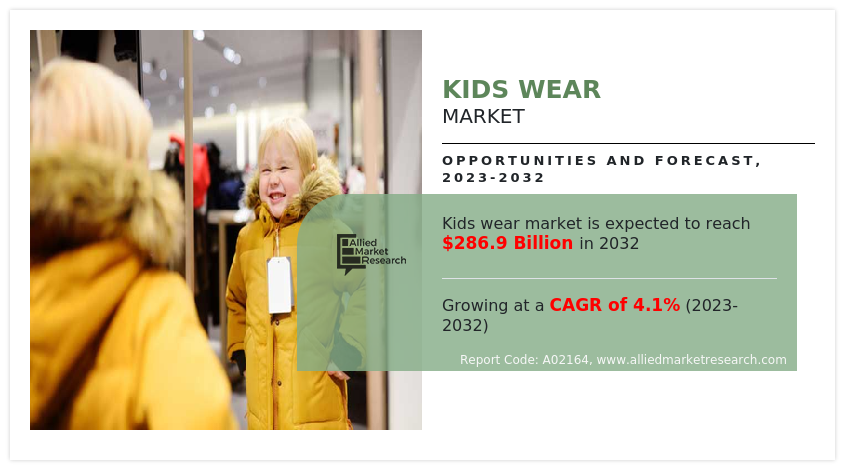
The kids wear market is segmented into Product Type, End Users and Distribution Channel.
SEGMENTAL OVERVIEW
The kids wear market is analyzed on the basis of product type, end user, distribution channel and region. By product type, it is divided into apparel, footwear and accessories. By end user, it is bifurcated into boys and girls. By distribution channel it is categorized into supermarket & hypermarket, online stores, specialty stores, and brand outlets. Region wise, it is analyzed across North America, Europe, Asia-Pacific, and LAMEA.
BY PRODUCT TYPE
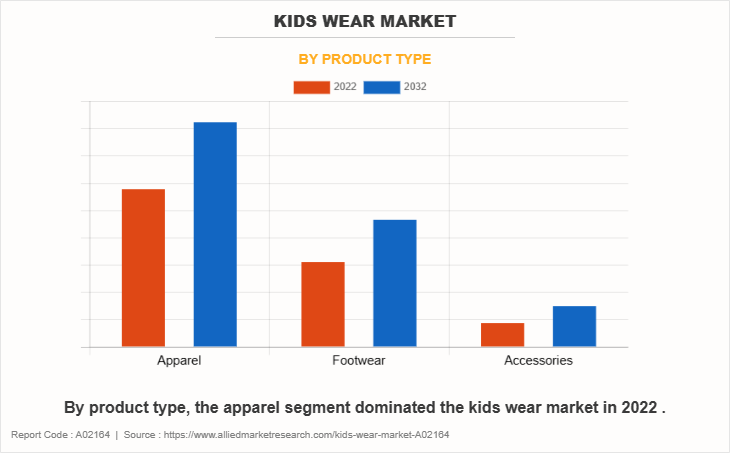
By product type, the apparel segment dominated the kids wear market in 2022 and is anticipated to maintain its dominance throughout the forecast period. The term "apparel" refers to the vast range of clothes and items that individuals wear on a daily basis. Tops like blouses and sweaters, bottoms like slacks and skirts, outerwear like coats and jackets, and gowns for special occasions are considered under this category. The demand for eco-friendly materials and ethical manufacture has led to a growth in the popularity of sustainability and ethical fashion. The market has changed due to digital transformation, as e-commerce and online shopping experience traction.
BY END USER
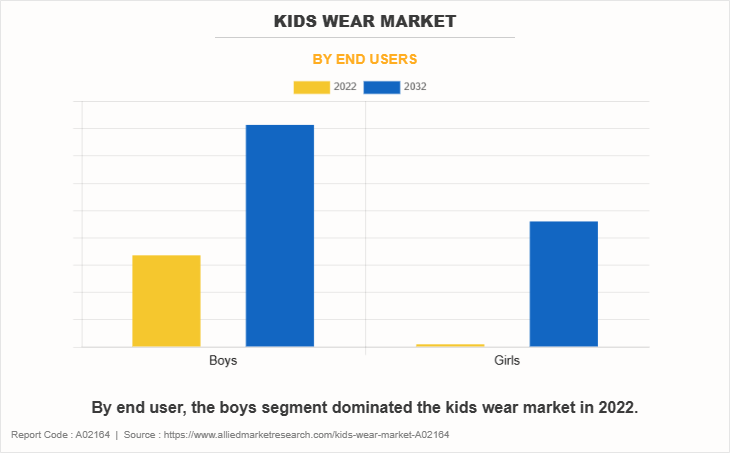
By end user, the boys segment dominated the kids wear market in 2022 and is anticipated to maintain its dominance throughout the forecast period. While eco-conscious customers have become more aware of sustainability and eco-friendly clothing options, athleisure wear, which emphasizes comfort and versatility, is still popular. Character licensing continues to enthrall younger audiences, and the advent of gender-neutral fashions accommodates a wider spectrum of fashion choices. Adolescent boys tend to choose streetwear and urban styles, such as sneakers and graphic tees. The demand for boys segment has increased due to the promoting factors which include chances for international expansion, the growing significance of internet retail, and the cyclical need for apparel. Companies thrive in this dynamic market by meeting the varied needs and preferences of boys and their parents by prioritizing sustainability, embracing gender-neutral fashion, working with well-known characters, excelling in online marketing, innovating with materials and technologies, and by producing high-quality school uniforms.
BY DISTRIBUTION CHANNEL
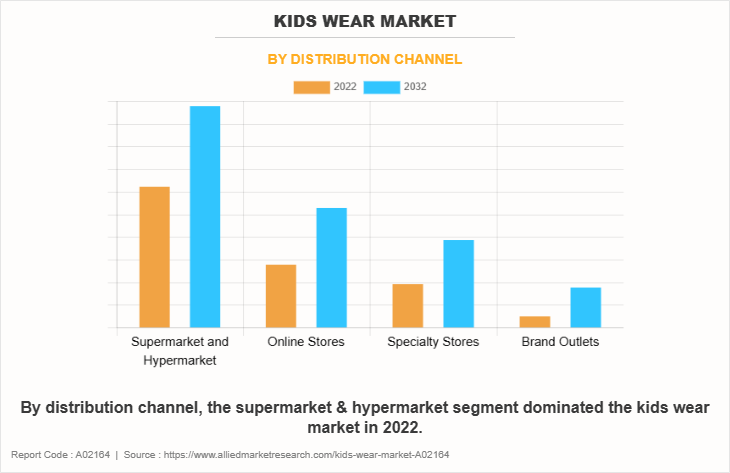
By distribution channel, the supermarket & hypermarket segment dominated the kids wear market in 2022 and is anticipated to maintain its dominance throughout the forecast period. Supermarkets and hypermarkets are important players in the kids' clothing business since they provide a large selection of kids' clothes. This entails offers a wide selection of clothing for children, supports private label labels for affordable yet high-quality options, embraces seasonal sales and sustainability, and enhances their web presence to appeal to online buyers. Customer happiness and retention is improved by fostering inclusivity and variety in apparel selections, which provide personalization. Furthermore, licensing and partnership agreements with well-known kids' brands have provided an advantage in production of distinctive and eye-catching kids' clothing collections. Retailers also use data analytics to better understand consumer preferences and boost sales in this cutthroat industry.
BY REGION
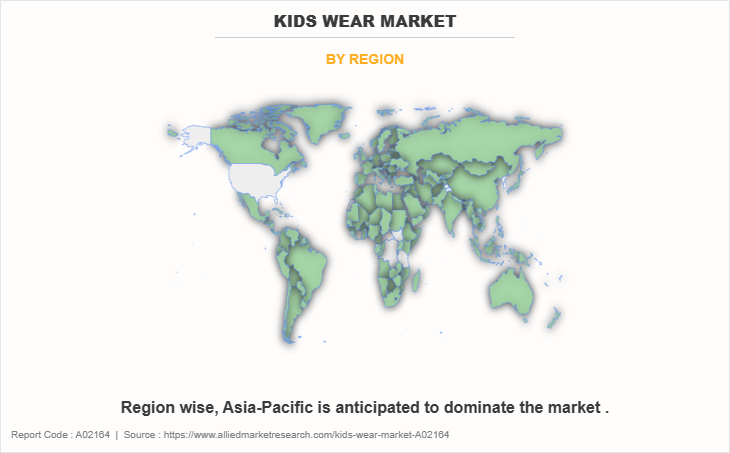
Region wise, Asia-Pacific is anticipated to dominate the market with the largest share during the forecast period. In the market for kids wear, Asia-Pacific is both the largest and one of the fastest expanding region. Rise in disposable income levels empower families to invest in high-quality and fashionable clothing for their children. Rapid urbanization has altered lifestyle preferences and created a distinctive demand for urban-centric children's clothing. The increased brand awareness, facilitated by global and local children's clothing brands and the influence of digital media, has led to a preference for branded kids' wear. The growth of e-commerce and digital adoption has made a broader range of children's clothing accessible to parents, further fueling market expansion. Moreover, the adoption of global fashion trends and changing family structures have resulted in more stylish and individualized clothing choices for children which aligns with evolving consumer preferences in the region.
COMPETITION ANALYSIS
The major players analyzed for the kids wear market include H&M Group , Ralph Lauren Corporation , Dolce & Gabbana S.r.l. , Marks and Spencer plc , Industria de Diseno Textil, S.A. , Gap Inc. , The Walt Disney Company , The Children's Place, Inc. , Under Armour, Inc. , and Carter’s, Inc. .Manufacturers of kids wear market are always creating new products and formulae to satisfy the change in requirements of their customers. They make investments in R&D to create novel combinations of ingredients with enhanced functionality, stability, and selectivity and create new applications for kids wear market. Manufacturers of kids wear are frequently working with innovative product producers, regulatory organizations, and other industry players for developing new products. Manufacturers are expected to increase their capacities, pool their knowledge, and create novel solutions through these collaborations.
Manufacturers have improved their production capacity and cost cutting, which are expected to involve both investing in new production facilities and renovating current ones to keep up with the rise in demand for kids wear. Furthermore, manufacturers of kids wear are anticipated to merge with or buy other businesses to broaden their product lines, get access to new markets or technologies, or do both at the same time. Manufacturers are expected to benefit from merging and acquiring businesses by expanding their product lines, gaining a larger market share, and enhancing their economies of scale.
Key Benefits For Stakeholders
- This report provides a quantitative analysis of the market segments, current trends, estimations, and dynamics of the kids wear market analysis from 2022 to 2032 to identify the prevailing kids wear market opportunities.
- The market research is offered along with information related to key drivers, restraints, and opportunities.
- Porter's five forces analysis highlights the potency of buyers and suppliers to enable stakeholders make profit-oriented business decisions and strengthen their supplier-buyer network.
- In-depth analysis of the kids wear market segmentation assists to determine the prevailing market opportunities.
- Major countries in each region are mapped according to their revenue contribution to the global market.
- Market player positioning facilitates benchmarking and provides a clear understanding of the present position of the market players.
- The report includes the analysis of the regional as well as global kids wear market trends, key players, market segments, application areas, and market growth strategies.
Kids Wear Market Report Highlights
| Aspects | Details |
| Market Size By 2032 | USD 286.9 billion |
| Growth Rate | CAGR of 4.1% |
| Forecast period | 2022 - 2032 |
| Report Pages | 288 |
| By Product Type |
|
| By End Users |
|
| By Distribution Channel |
|
| By Region |
|
| Key Market Players | Under Armour, Inc., H&M Group, Industria de Diseno Textil, S.A., Marks and Spencer plc, Carter’s, Inc., Gap Inc., The Walt Disney Company, Ralph Lauren Corporation, The Children's Place, Inc., Dolce & Gabbana S.r.l. |
Analyst Review
Kids wear market has witnessed steady growth in recent years. From a Chief Experience Officer (CXO) perspective, the kids' wear market offers a unique set of challenges and opportunities. It is essential to prioritize a customer-centric approach that caters not only to the preferences and comfort of children but also the concerns and tastes of their parents to excel in this industry. Product innovation should focus on creating clothing that is not just trendy but also functional and safe. Sustainability is a growing concern in the fashion industry, and embracing eco-friendly practices in design and sourcing can set a brand apart. An omni-channel presence that seamlessly combines online and in-store experiences is vital, while personalization and customization can enhance customer engagement. Safety and compliance with industry standards must be paramount, and effective branding and marketing strategies should resonate with both parents and children.
The rise in rate of internet penetration around the major parts of the world makes way for manufacturers to initiate several key online marketing programs as online platforms are one of the easiest ways to create awareness about the specifications and features of the athleisure products among the target customers.
Moreover, data analytics and technology has leveraged to understand customer behavior and trends, while supply chain efficiency, partnerships, and collaborations have provided a competitive edge. Proactively gathering and acting on customer feedback, staying informed about industry trends, and forecasting market shifts are also critical for success in the dynamic kids wear market.
Asia-Pacific holds the maximum market share of the Kids wear market .
The apparel segment is the most influential segment in the Kids wear market report..
The global kids wear market was valued at $194,100 million in 2022, and is projected to reach $286,883 million by 2032, registering a CAGR of 4.1% from 2023 to 2032.
The forecast period in the Kids wear market report is 2023 to 2032.
The market value of the Kids wear market in 2022 was $ 286,883million.
The company profile has been selected on the basis of revenue, product offerings, and market penetration.
The base year calculated in the Kids wear market report is 2022.
The major players analyzed for the kids wear market include H&M Group , Ralph Lauren Corporation , Dolce & Gabbana S.r.l. , Marks and Spencer plc , Industria de Diseno Textil, S.A. , Gap Inc. , The Walt Disney Company , The Children's Place, Inc. , Under Armour, Inc. , and Carter’s, Inc.
Loading Table Of Content...
Loading Research Methodology...


